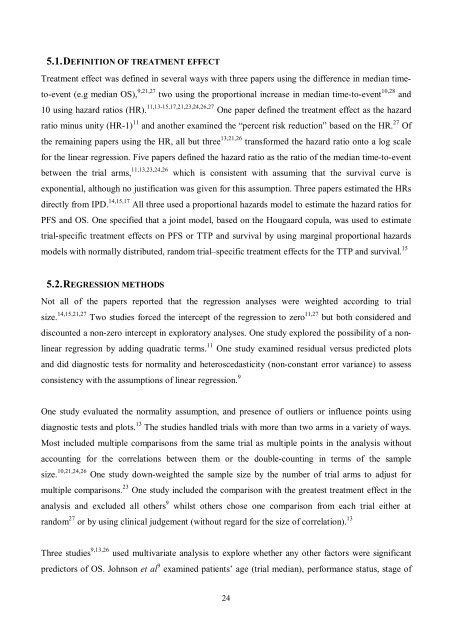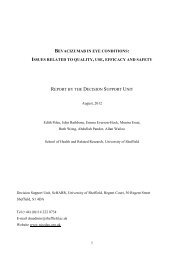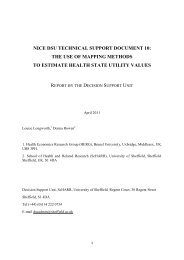A review of studies examining the relationship between progression ...
A review of studies examining the relationship between progression ...
A review of studies examining the relationship between progression ...
You also want an ePaper? Increase the reach of your titles
YUMPU automatically turns print PDFs into web optimized ePapers that Google loves.
5.1. DEFINITION OF TREATMENT EFFECTTreatment effect was defined in several ways with three papers using <strong>the</strong> difference in median timeto-event(e.g median OS), 9,21,27 two using <strong>the</strong> proportional increase in median time-to-event 10,28 and10 using hazard ratios (HR). 11,13-15,17,21,23,24,26,27 One paper defined <strong>the</strong> treatment effect as <strong>the</strong> hazardratio minus unity (HR-1) 11 and ano<strong>the</strong>r examined <strong>the</strong> “percent risk reduction” based on <strong>the</strong> HR. 27 Of<strong>the</strong> remaining papers using <strong>the</strong> HR, all but three 13,21,26 transformed <strong>the</strong> hazard ratio onto a log scalefor <strong>the</strong> linear regression. Five papers defined <strong>the</strong> hazard ratio as <strong>the</strong> ratio <strong>of</strong> <strong>the</strong> median time-to-event<strong>between</strong> <strong>the</strong> trial arms, 11,13,23,24,26 which is consistent with assuming that <strong>the</strong> survival curve isexponential, although no justification was given for this assumption. Three papers estimated <strong>the</strong> HRsdirectly from IPD. 14,15,17 All three used a proportional hazards model to estimate <strong>the</strong> hazard ratios forPFS and OS. One specified that a joint model, based on <strong>the</strong> Hougaard copula, was used to estimatetrial-specific treatment effects on PFS or TTP and survival by using marginal proportional hazardsmodels with normally distributed, random trial–specific treatment effects for <strong>the</strong> TTP and survival. 155.2. REGRESSION METHODSNot all <strong>of</strong> <strong>the</strong> papers reported that <strong>the</strong> regression analyses were weighted according to trialsize. 14,15,21,27 Two <strong>studies</strong> forced <strong>the</strong> intercept <strong>of</strong> <strong>the</strong> regression to zero 11,27 but both considered anddiscounted a non-zero intercept in exploratory analyses. One study explored <strong>the</strong> possibility <strong>of</strong> a nonlinearregression by adding quadratic terms. 11 One study examined residual versus predicted plotsand did diagnostic tests for normality and heteroscedasticity (non-constant error variance) to assessconsistency with <strong>the</strong> assumptions <strong>of</strong> linear regression. 9One study evaluated <strong>the</strong> normality assumption, and presence <strong>of</strong> outliers or influence points usingdiagnostic tests and plots. 13 The <strong>studies</strong> handled trials with more than two arms in a variety <strong>of</strong> ways.Most included multiple comparisons from <strong>the</strong> same trial as multiple points in <strong>the</strong> analysis withoutaccounting for <strong>the</strong> correlations <strong>between</strong> <strong>the</strong>m or <strong>the</strong> double-counting in terms <strong>of</strong> <strong>the</strong> samplesize. 10,21,24,26 One study down-weighted <strong>the</strong> sample size by <strong>the</strong> number <strong>of</strong> trial arms to adjust formultiple comparisons. 23 One study included <strong>the</strong> comparison with <strong>the</strong> greatest treatment effect in <strong>the</strong>analysis and excluded all o<strong>the</strong>rs 9 whilst o<strong>the</strong>rs chose one comparison from each trial ei<strong>the</strong>r atrandom 27 or by using clinical judgement (without regard for <strong>the</strong> size <strong>of</strong> correlation). 13Three <strong>studies</strong> 9,13,26 used multivariate analysis to explore whe<strong>the</strong>r any o<strong>the</strong>r factors were significantpredictors <strong>of</strong> OS. Johnson et al 9 examined patients’ age (trial median), performance status, stage <strong>of</strong>24





